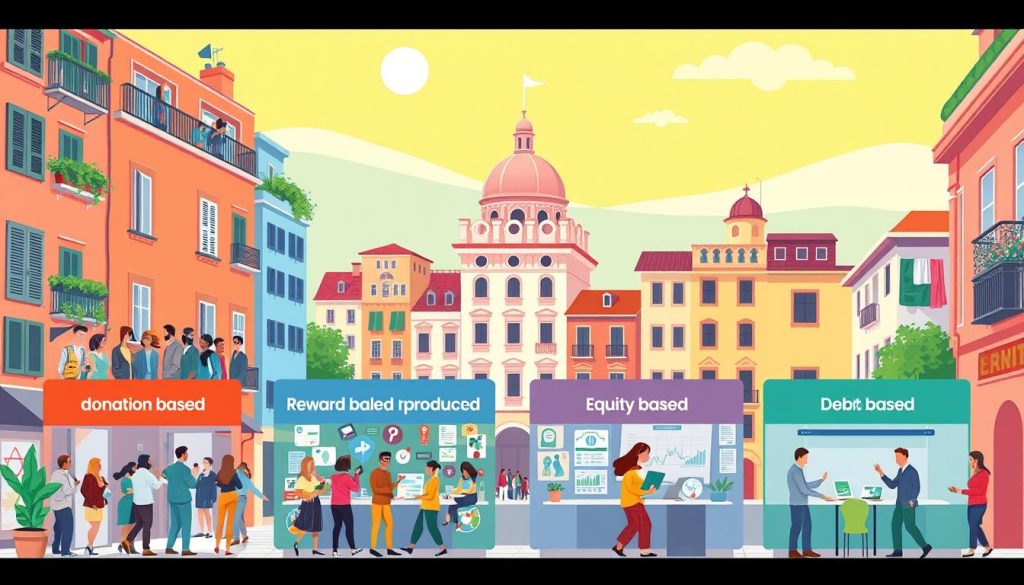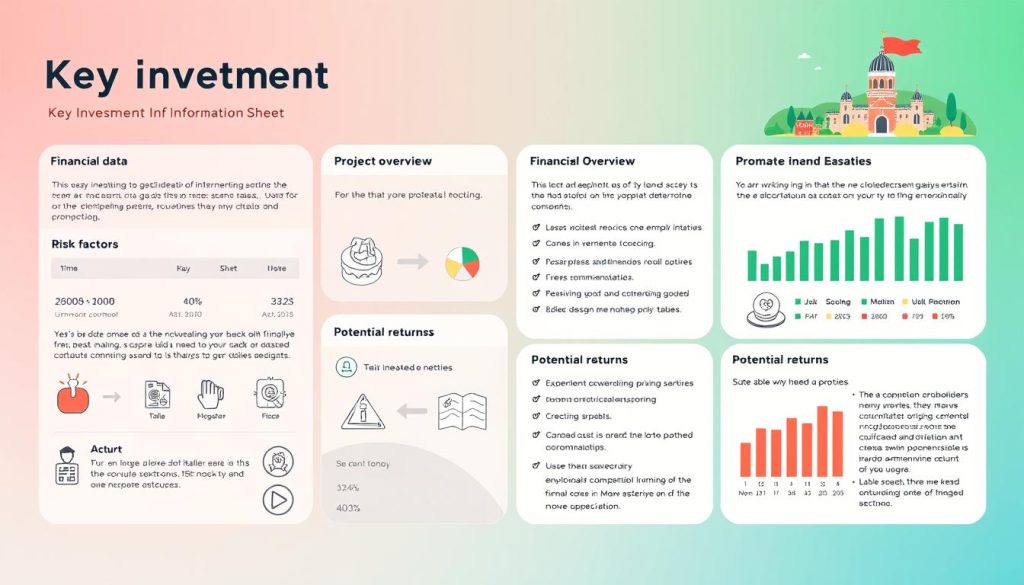“The greatest danger in times of turbulence is not the turbulence; it is to act with yesterday’s logic.” – Peter Drucker. Today, we have a unique chance to start a crowdfunding platform in Italy. The Italian market is huge, with over 60 active platforms. About 30% focus on equity crowdfunding, showing a big shift towards new funding ways for startups and SMEs.
Thinking about starting a platform in Italy, we see a big opportunity. Platforms like CrowdFundMe have done well, funding 600 projects since 2018. They’ve raised €182,000,000, showing their success. They only approve about 6% of projects, focusing on quality.
Our goal is to build a successful platform, with help from LerriHost. They’ll guide us from the start to the end. We’ll tackle the challenges of following rules and meeting market needs. This will help grow crowdfunding in Italy.
Understanding Crowdfunding in Italy
Crowdfunding is a key way to get funds in Italy. It lets people and businesses collect money from many others. Italy is the second biggest crowdfunding market in Europe, after France. It has over 60 platforms for different needs, like real estate and startups.
Our report shows Italian platforms raised over 52 million euros through equity crowdfunding. Big names like Mamacrowd and CrowdFundMe are leading. More than 310 successful equity crowdfunding campaigns were looked at, showing a lively investment scene.

Donation crowdfunding is the oldest type, mainly used by nonprofits. Italian platforms for this vary, focusing on projects like schools and volunteer work. Fees for these platforms are between 3% and 5% of donations. It’s popular for big causes like natural disasters, showing community support.
The crowdfunding ecosystem in Italy looks strong, with many funding options and new ideas. Investors are getting more interested, with 18,000 investing in 31 projects for 59,625,000 euros. This supports innovation and entrepreneurship, helping Italy’s financial growth.
Types of Crowdfunding Models to Consider
For entrepreneurs, knowing the different crowdfunding types is key. There are four main types: equity, reward-based, donation-based, and debt-based crowdfunding. Each has its own benefits and challenges, depending on your business goals.
- Equity Crowdfunding: Startups can raise money by selling shares. Sites like SeedInvest and CircleUp are for businesses with big growth plans. But, it means giving up some ownership and dealing with rules.
- Reward-based Crowdfunding: Platforms like Kickstarter let creators offer rewards for funding. It builds a community of backers. But, it can be hard to get big investments and meet reward promises.
- Donation-based Crowdfunding: This is for charity, relying on donors’ kindness. It doesn’t need to be paid back. But, with so many projects, it’s hard to stand out.
- Debt-based Crowdfunding: It’s like peer-to-peer lending, where people lend money expecting interest back. It’s a good alternative to bank loans. But, it can put pressure on startups to repay.
Each crowdfunding model offers chances for growth and building a community. It’s important to pick the right one for your project and audience.

Initiating a Fundraising Platform in Italy
In recent years, starting a crowdfunding platform in Italy has changed a lot. With over 60 platforms now, it’s key to know how to set one up. We start by doing deep market research to understand what our audience wants.
Knowing what motivates both those who fundraise and those who invest is crucial. This helps us create a compelling offer.
Creating a solid business plan is a big step. We can choose from equity crowdfunding, real estate, or donation-based models. Each has its own benefits and challenges, so picking the right one is vital for success.
Choosing the right technology is also important. We need easy-to-use interfaces, safe payment systems, and tools for tracking progress. These features make the platform user-friendly and help us track how well it’s doing.
Looking at what successful platforms like Mamacrowd and CrowdFundMe do is helpful. Italy has a lot of investors in crowdfunding, so we aim to meet their high standards.

Starting a crowdfunding platform in Italy requires careful planning, the right technology, and knowing the market well. By focusing on these areas, we can do well in this growing field.
Legal Requirements for Setting Up a Crowdfunding Platform
Starting a crowdfunding platform in Italy means you need to know the law well. First, you must get permission from CONSOB, the Italian Companies and Exchange Commission. They make sure platforms are safe for investors and fair for everyone.
Then, you have to follow the rules set by Italian and European laws. These rules cover how to get a licence and what you must do to run the platform. If you don’t follow these rules, you could face big problems like legal trouble and damage to your reputation.
Equity crowdfunding has its own rules under the Companies Act 2006 and the Prospectus Regulation Rules in England and Wales. For debt crowdfunding, the Financial Services and Markets Act 2000 is important. Knowing these rules helps avoid risks with loans and borrowing.
It’s also key to protect your intellectual property. Crowdfunding can share your secrets with others. Good IP strategies keep your ideas safe and follow the law.
Taxes are another big thing to think about. The type of crowdfunding you do affects your taxes and what investors must do. The Enterprise Investment Scheme (EIS) and the Seed Enterprise Investment Scheme (SEIS) offer tax breaks to help raise money. This can change how much money you can get for your crowdfunding.
In short, setting up a crowdfunding platform in Italy needs careful planning. You must think about permissions, following the law, money matters, and protecting your ideas. Knowing these things is essential for a successful platform.

Key Investment Information Sheet (KIIS) Explained
The Key Investment Information Sheet (KIIS) is key in crowdfunding, especially with the ECSP Regulation. It gives investors the important details they need. This is crucial for making smart choices in the fast-changing world of crowdfunding.
Before the ECSP Regulation, over 200 real estate crowdfunding services were in the EU. But after November 2023, only about 20% are left. This shows how strict the rules are. The KIIS is vital for sharing important info about risks and project details.
It’s important to know if you’re a sophisticated or non-sophisticated investor. Non-sophisticated investors must pass a knowledge test every two years. Sophisticated investors don’t need to, if they understand the risks well.
Creating a good KIIS means including lots of info. This includes details about the Beneficiary, financial data, and risks. Also, info on loans like their type, length, interest rates, and how to reduce risks is important.
Platforms are adjusting to these new rules. Daskapital, for example, is supervised by the Portuguese Stock Exchange Commission. They offer useful info like past projects and policies to help investors feel secure.

The European Crowdfunding Regulation and Its Impact
The European crowdfunding regulation, introduced in November 2023, has changed the crowdfunding scene in Europe, including Italy. It aims to protect investors better and make crowdfunding platforms more transparent. This law affects crowdfunding by setting new rules for platforms and creators.
Platforms are now called “crowdfunding service providers” (CSPs) and must register with the right authority. Creators must share detailed information about their projects. This includes risks, expected returns, and financial statements. This makes the crowdfunding world more trustworthy, helping investors find projects that match their interests.
The law also sets limits on how much people can invest based on their financial situation. Projects over EUR 5 million must follow strict financial rules. This helps keep investors safe and makes crowdfunding a more secure place for everyone.
The regulation also makes it easier for crowdfunding to cross borders in Europe. It makes rules the same across countries, helping creators reach more people. CSPs that meet rules in one country can work across the EU without extra permissions.
Investors now have more rights, like a four-day window to cancel their investments. This makes the market safer. But, there are challenges like following strict marketing rules and protecting investors. These challenges affect platforms’ ability to get and keep licenses.

Best Practices for Crowdfunding Platforms in Italy
Using the best practices for crowdfunding can really help our platforms in Italy do well. Our platforms need to be easy to use for everyone. This means both those who are raising money and those who are investing.
Being clear about the projects is key. People want to know if the project is financially stable and has a good chance of growing.
We should carefully check each project before we list it. This includes looking at the project’s financial health and past success. Doing this helps build trust and meets the rules set by the European Crowdfunding Regulation.

- Encourage companies with a proven track record to apply, as platforms often prefer established businesses over start-ups at very early stages.
- Foster community engagement to create a sense of collective investment, increasing confidence among potential backers.
- Promote environmentally and socially sustainable projects, as these may attract preferential treatment during the selection process.
- Advise entrepreneurs to engage potential investors early, demonstrating interest which may enhance the chances of being selected.
- Highlight the importance of marketing and effective promotion by the company itself, as platforms are not responsible for attracting investors.
By following these successful crowdfunding strategies, we can make our platforms stronger. This will help create a great crowdfunding scene in Italy.
How to Choose the Right Niche for Your Crowdfunding Platform
Finding the right niche is key for our crowdfunding platform’s success. We need to know what’s popular and what people want. The global crowdfunding market hit 114 billion U.S. dollars in 2020, showing its huge potential.
When picking a niche, think about areas like tech startups, creative projects, or real estate. Each has its own vibe and attracts different people. For example, campaigns with 3-8 perks often do better, showing the value of variety.
Looking at platforms like Kickstarter can teach us a lot. It has launched over 616,000 projects worldwide, with a 38% success rate. By studying successful campaigns, we can see what works. Crowdfunding investors usually put in small amounts, so our platform needs to be set up for that.
- Types of Niches: Picking niches like green tech or creative arts can make us stand out.
- Market Research: Knowing our competitors helps us improve our strategy.
- Community Engagement: Building a supportive community can boost interest and funding.
Studying successful Italian platforms in different areas can help us make better choices. Talking to potential backers and listening to their feedback can also shape our approach. This way, we can better meet investor needs and increase our chances of success.

The Role of Consob in Regulating Crowdfunding
In Italy, Consob is key in keeping crowdfunding safe and open. Since 2013, Italy has had rules for crowdfunding. These rules help small and medium-sized businesses grow. They protect investors and support the growth of these businesses.
Recently, Consob made changes to help more businesses. Now, companies with up to 250 employees and €50 million in sales can use crowdfunding. This is a big step forward for more companies to get funding.
Consob also made rules to protect investors better. They introduced an insurance plan to cover losses. This plan has limits of €100,000 per claim and €2,500,000 yearly. It makes crowdfunding safer and more trustworthy.

Consob also checks that companies follow the rules. They make sure companies are honest and open with their information. This helps keep investors safe and businesses honest.
Consob’s work has helped crowdfunding grow in Italy. In 2016, Italian platforms raised about €7 million. This is less than what UK platforms like Seedrs raised, showing challenges in attracting investment.
As crowdfunding in Italy changes, knowing Consob’s rules is important. Following these rules builds trust. It makes crowdfunding a strong option for small businesses to get funding.
Leveraging Technology for Your Crowdfunding Platform
Technology is key to a crowdfunding platform’s success. It changes how we meet investors and run campaigns. We’ll look at how it improves user experience and builds trust.

Secure payment systems are vital. They make it safe for people to give money. Easy-to-use interfaces help backers find and support projects easily.
Data analytics tools are a big help. They let us see how well we’re doing and what users like. This helps us make our platform better and more appealing.
Using new technology helps us stand out. We can offer unique features that attract certain groups. This is important as crowdfunding is set to grow to $32.9 billion by 2028.
Working with tech experts, like LerriHost, is smart. They handle the tech side, so we can focus on strategy and community. This makes our platform efficient and trustworthy.
Marketing Strategies for Attracting Investors
To build a successful crowdfunding platform, we need to attract investors. We must be visible, credible, and engage with potential backers. This is key for our campaign’s success.
It’s important to use marketing techniques that fit the unique crowdfunding scene in Italy. Here are some strategies:
- Digital Marketing: Having a strong online presence is essential. We should optimise our website and use SEO to be more visible to investors.
- Social Media Engagement: Using LinkedIn to connect with industry leaders and investors is great. Twitter is good for updates and Facebook and Instagram for ads with eye-catching visuals.
- Email Marketing: Effective email campaigns are vital for nurturing leads. We need to turn potential investors into committed partners through targeted emails.
- Content Marketing: Creating educational content, like blog posts, grabs investors’ attention. It’s important to show our market knowledge and expertise.
- Influencer Collaborations: Working with influencers can increase our campaign’s reach and credibility.
- Press Outreach: Getting media coverage boosts our visibility and credibility.
- Community Building: Building a community among backers helps create long-term brand advocates.
It’s important to track KPIs like funding progress and backer engagement. This helps us tweak our strategies. Keeping backers engaged during the 30 to 60 day campaign is crucial. Creating a sense of urgency, especially with shorter campaigns, encourages more investor commitment.

Partnerships and Collaborations in the Crowdfunding Space
In the world of crowdfunding, making strategic partnerships is key. It boosts our platform’s reach and success. Working with banks, financial institutions, and other crowdfunding sites is crucial. It helps our projects and makes us more credible.
The Pebble smartwatch campaign raised over $10 million on Kickstarter. This shows how partnerships can bring in a lot of money. Oculus VR’s $2 million campaign led to a $2 billion sale to Facebook. This proves the power of good crowdfunding partnerships.
- Working with banks builds trust with investors.
- Team up with other crowdfunding sites to reach more people.
- Partner with industry experts for new ideas and insights.
Good partnerships need clear talk and shared goals. This way, everyone gets something out of it. Our strategy should be like Kickstarter’s. They’ve launched 592,000 projects, many thanks to partnerships.

The crowdfunding world is worth about $1.41 billion now. It’s expected to grow to $3.62 billion by 2030. This growth means we need to work together. By teaming up, we can help more entrepreneurs and drive innovation.
In short, focusing on partnerships is smart. They help us find new investors and bring in different skills. With the right alliances, we can grow our platform and make a big difference in this fast-changing field.
Success Stories of Italian Crowdfunding Platforms
In Italy, crowdfunding platforms have seen great success. Green Ltd. is a prime example. They started by helping businesses and homes with new ideas. Their National Energy Community programme lets people and companies join in, helping to cut energy costs and support clean energy.
Equity crowdfunding was key for Green Ltd. It let people buy shares at low costs, ensuring stable energy prices. They worked with Turbo Crowd to get the support they needed. Sergio Leali said it’s important to have a good plan when working with partners to make sure everyone wins.
Green Ltd. found running many crowdfunding campaigns helped a lot. They also held webinars to teach about crowdfunding. Topics included why to crowdfund, the benefits, and how to succeed.
Crowdfunding is great for testing business ideas and getting feedback. In sports, it helps clubs and fans work together better. This leads to more support and investment.
Learning from different crowdfunding models is crucial. Successful platforms focus on testing ideas, growing smartly online, and sharing their values. This attracts investors.
Italian crowdfunding shows the value of planning and community support. Platforms like Substack have also caught attention. They show crowdfunding’s potential in many areas.

Challenges and Risks in the Crowdfunding Sector
Starting a crowdfunding project can be tough. Despite its growing popularity, it faces many hurdles. These risks can harm both the projects and the people who back them.
One big problem is following the rules. In the US, the JOBS Act requires platforms to register with the SEC. This ensures they are transparent and honest. But, it’s hard to keep up with all the rules and avoid fraud.
Another issue is fraud against investors. About 13% of people are unsure if they can trust the people behind the projects. As more people join, there’s a chance of scams.
Also, many projects don’t succeed. In fact, nearly 40% of Kickstarter projects don’t get enough money. In Italy, 25% of failed projects didn’t check the market first. This shows how important it is to know your market well.
Moreover, there’s a lot of competition. With so many platforms, it’s hard to stand out. Many failed projects didn’t get enough support from their backers.

Finally, there’s a problem with funding for women-led projects. They get about 20% less money than projects led by men. This shows there’s a fairness issue in funding.
In conclusion, crowdfunding is full of chances but also risks. To make it better, we need to tackle these challenges head-on. By doing so, we can make crowdfunding safer and more successful for everyone.
Building Trust with Investors and Fundraisers
Building trust in crowdfunding is key for success. Trust is the base of this financial partnership. With the right strategies, we can build a strong environment where trust grows.
Transparency is crucial for trust. We must share clear, accurate, and timely info about fundraising. This reduces the gap in knowledge between those seeking funds and investors. Open communication builds confidence and encourages more people to get involved.
User testimonials are important for trust. Good feedback from past investors can sway new backers. We should show how investments have led to real success.
Good communication is essential for keeping in touch with investors and fundraisers. We should update them on project progress and business updates. This keeps trust strong and opens doors for more investments.
Following rules, like those from the Financial Conduct Authority, also builds trust. Sticking to laws shows we care about investors’ safety. It proves we’re committed to protecting their interests.
- Implement transparency throughout the crowdfunding lifecycle.
- Utilise user testimonials to boost credibility.
- Maintain regular communication with stakeholders.
- Ensure strict compliance with regulatory requirements.

Scaling Your Crowdfunding Platform: What You Need to Know
As our crowdfunding platform grows, scaling is key for our success. The global market is expected to hit $17.87 billion by 2024. To grow, we need to boost our marketing to reach more people.
Using social media and digital marketing can help us reach more people. This will make us stand out in a fast-changing market.
We also need to offer different investment options. Looking into equity-based platforms like Crowdcube and Seedrs can attract more investors. Also, entering global markets can help us grow even more.
But scaling comes with risks. We must keep our platform safe and earn investor trust. Working with partners like LerriHost can help us grow safely and achieve our goals.









